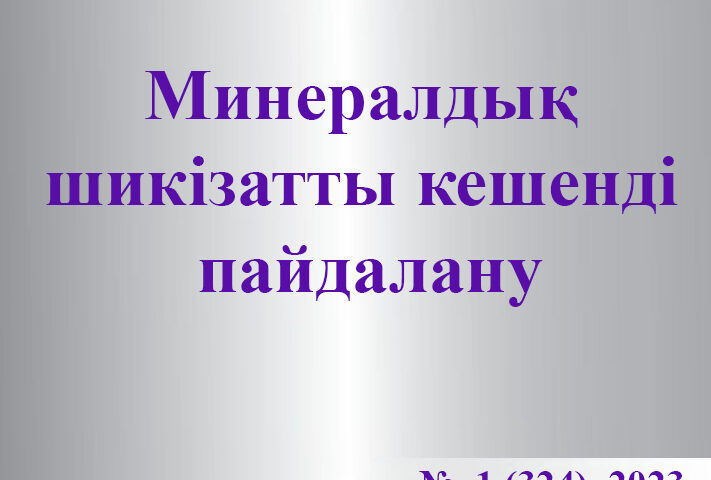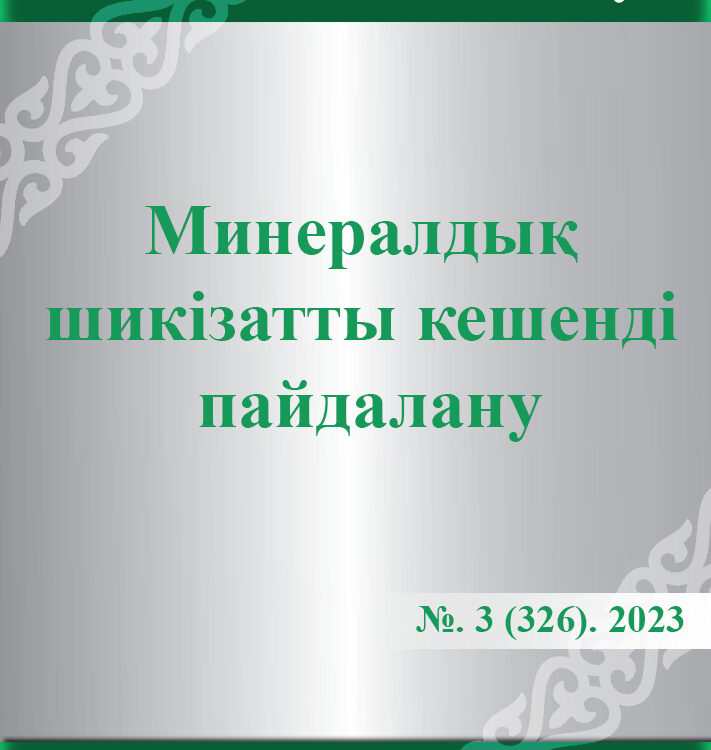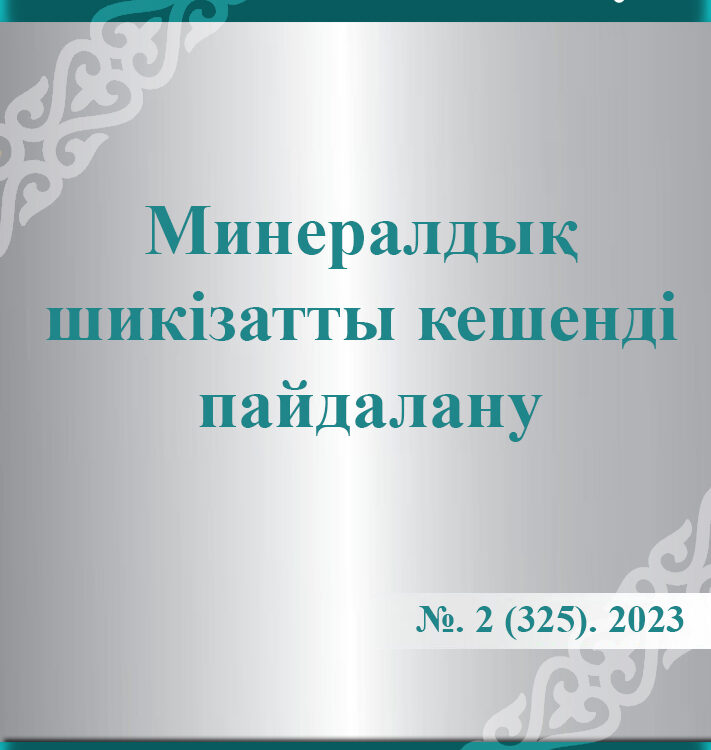Title: Improving the efficiency of methane extraction from coal seams
Authors: Rabatuly M., Musin R.A., Demin V.F., Usupaev Sh.Е. , Kenetaeva A.A.
Abstract: This article presents possible reasons for the low productivity of wells for coal methane extraction and ways to resolve them using hydrochloric acid treatment of wells. A common reason for the low productivity of wells is a decrease in the permeability of the bottom-hole formation zone. Starch, calcium carbonate, and drilling rocks, which are part of the drilling mud, change the filtration properties of the layer during the formation of a filtration crust and lead to a decrease in the initial permeability. Hydrochloric acid treatment, during which clay rocks are dissolved, is an effective method of increasing the productivity of wells. It is used to increase pick-up and prevent contamination of the bottom-hole zone of the carbonate formation. The parameters affecting the effectiveness of hydrochloric acid treatments were considered. The results of the experience of the interaction of hydrochloric acid with a clay crust are presented and analyzed using approaches to the mechanics of multiphase media. Dependences of the rate of dissolution of clay rock on the concentration of acid solution are obtained. It is established that the treatment of the productive intermediate layer of the well with hydrochloric acid in a certain concentration, its use increases the technological and economic efficiency of wells. As a result of experimental work, it was found that hydrochloric acid with an HCL concentration above 18% has a negative effect on the internal equipment of the well when processing clay shells.
Keywords: safety, coal mines, colmatation, wells, clay crust, hydrochloric acid.
Cite this article as: Rabatuly M, Musin RA, Demin VF, Usupaev ShЕ, Kenetaeva AA. Improving the efficiency of methane extraction from coal seams. Kompleksnoe Ispolzovanie Mineralnogo Syra = Complex Use of Mineral Resources. 2023; 324(1):5-11. https://doi.org/10.31643/2023/6445.01
Title: Studies of the influence of the composition of the CHM on the properties of the casting
Authors: Isagulov A.Z., Kulikov V.Y., Кvon S.S., Michot G., Alina A.A.
Abstract: The quality of the finished casting is largely determined by the quality of the mold. Currently, there are a large number of variations in the composition of CHM (cold hardening mixes), differing both in the nature of the main component and in the nature and ratio of binders and other technological additives. As cleaning dust has a very developed surface due to technological reasons. According to various estimates, the specific surface area of gas cleaning dust is from 8, 000 cm2/g and higher. In order to verify this assumption, studies were conducted on the effect of the composition of the mixture using SCF (sand-clay forms), on some of its properties. In conclusion, the conducted studies have shown that in order to ensure the maximum performance of the technological properties of CHM, the optimal content of SCF in the mixture should be 2.0 - 10.0 wt.% in the ratio with orthophosphoric acid is not higher than 1.25.
Keywords: CHM, SCF, casting, properties, mixture, strength, surface.
Cite this article as: Isagulov AZ, Kulikov VY, Кvon SS, Michot G, Alina AA. Studies of the influence of the composition of the CHM on the properties of the casting. Kompleksnoe Ispolzovanie Mineralnogo Syra = Complex Use of Mineral Resources.2023;324(1):12-17. https://doi.org/10.31643/2023/6445.02
Title: Justification of the stress-strain state’s parameters of the mine workings contours depending on the influencing factors
Authors: Demin V.F., Zhurov V.V.
Abstract: The complication of mining and geological conditions is associated with the involvement in the development of areas and entire deposits with complex tectonics, an increase in the depth of development, the manifestation of dangerous dynamic effects of rock pressure, which necessitates the improvement of methods, systems, methods and means of supporting mine workings, as well as improving the quality of materials used for support. Mining and geological factors affecting the use of mining support include: the depth of occurrence, which determines the magnitude of the vertical and horizontal components of the rock pressure; layer thickness, developed deposit; bed angle; properties of the host rocks, structure and physical and mechanical properties of rocks and minerals. The paper presents the conduction of the analytical modelling of the rock mass stress-strain state around the active mine workings using the ANSYS software with the assessment of the influence of its cross-section shape and the angle of the coal seam fall on the value of the maximum stresses arising in the rock mass when the workings are supported with the anchoring support depending on the thickness of the easily collapsible rock layer at different lengths of anchoring.
Keywords: massif, mine development, stress-strain state, stress, anchoring.
Cite this article as: Demin VF, Zhurov VV. Justification the stress-strain state’s parameters of the mine workings contours depending on the influencing factors. Kompleksnoe Ispolzovanie Mineralnogo Syra = Complex Use of Mineral Resources. 2023;324(1):18-23. https://doi.org/10.31643/2023/6445.03
Title: Ways of Rare Earth Elements Migration and Transportation to the coals of the Shubarkol Deposit
Authors: Blyalova G.G., Kopobayeva A.N., Amangeldykyzy A., Askarova N.S., Ozhigin D.S.
Abstract: The article presents the results of studying the mineralogical and geochemical features of coals and clay interlayers of the Shubarkol deposit. There were analyzed 71 samples of clay layers and 49 samples of coal using the instrumental neutron activation analysis (INAA), powder X-ray diffractometry, and scanning electron microscopy. A comprehensive analysis of the geochemical and mineralogical characteristics of coals and their enclosing clay interlayers was carried out. A variety of geochemical criteria made it possible to establish the facts of the rare earth elements (REE) migration, and the latest data of mineralogy made it possible to establish the ways of their transportation to the paleobasin in the syn- and epigenetic periods of the Shubarkol deposit formation. The data of the paleoclimate and water composition of the paleobasin of peat formation are presented for the first time. Among other things, the analysis made it possible to identify a number of independent sources and various mechanisms of REE accumulation in the sediments of the Shubarkol deposit. The main patterns of the REE distribution that are expressed in the predominance of light lanthanides over heavy lanthanides, were established, and the role and composition of the rocks surrounding coal deposits in the concentration of REE were considered. Aluminosilicates, sulfides, and sulfates with inclusions of microparticles of rare and rare-earth REE elements were found in coals and clay interlayers.
Keywords: coal, Shubarkol, rare earth elements, mineralogy, geochemistry.
Cite this article as: Blyalova GG, Kopobayeva AN, Amangeldykyzy A, Askarova NS, Ozhigin DS. Ways of Rare Earth Elements Migration and Transportation to the coals of the Shubarkol Deposit. Kompleksnoe Ispolzovanie Mineralnogo Syra = Complex Use of Mineral Resources. 2023;324(1):24-33. https://doi.org/10.31643/2023/6445.04
Title: Flotation processing of copper-containing technogenic raw materials using a composite flotation reagent
Authors: Semushkina L.V., Tussupbayev N.K., Turysbekov D.K., Narbekova S.M., Kaldybayeva Zh.A.
Abstract: The article presents the results of laboratory research on the possibility of flotation processing of copper-containing technogenic raw materials. Studies were performed using a sample of copper-containing tailings obtained after the processing of copper ore from the Kazakhstan deposit and a composite flotation reagent. The application of a combination of various collectors allows for raising technological indicators of flotation. The purpose of the research is the increase extraction of copper at flotation of copper-containing technogenic raw materials with the application of a composite reagent. The studied sample of tailings contains 0.23% of copper. A mixture of sodium butyl xanthate and thionocarbamate in the ratio of 1:1 was used as a composite flotation reagent. Parameters of flotation of copper-containing tailings were worked out: degree of regrinding, charges of sodium butyl xanthate, blowing agent T-92, and a composite reagent. Composite flotation reagent was fed into the flotation process of copper-containing tailings in the form of emulsion produced in a T 18 digital ULTRA-TURRAX dispersant. The optimal emulsification time of the composite flotation reagent was 1 min. Without emulsification in the composite reagent the percentage of particles smaller than 1.192 μm is 55.047%. After emulsification of the composite reagent for 1 minute, the percentage of particles smaller than 1.192 μm is 91.134%. In optimum basic mode the rough copper concentrate with a copper content of 4.2% was obtained with the extraction of 61.56%. With the use of a composite reagent, a blister copper concentrate with a copper content of 4.5% and a recovery of 66.54% was obtained. Extraction of copper increases by 4,98%.
Keywords: copper-containing tails, flotation, flotation agent, emulsion, concentrate, recovery.
Cite this article as: Semushkina LV, Tussupbayev NK, Turysbekov DK, Narbekova SM, Kaldybayeva ZhA. Flotation processing of copper-containing technogenic raw materials using a composite flotation reagent. Kompleksnoe Ispolzovanie Mineralnogo Syra = Complex Use of Mineral Resources. 2023; 324(1):34-42. https://doi.org/10.31643/2023/6445.05
Title: Testing of the optimum extragent for solvent-extraction of Almaly deposit copper
Authors: Chepushtanova T.A., Yessirkegenov M.I., Mamyrbayeva K.K., Merkibayev Y.S., Nikolosky A.
Abstract: For the solvent extraction of copper from pregnant leach solutions, (PLS) a wide range of modern extractants is currently offered on the market, and its choice is a very important issue in the production of copper using the SX-EW (Solvent Extraction and Electrowinning) technology. The purpose of this work was to determine the optimal copper extractant for processing productive solutions of the Almaly deposit using the SX-EW. The studies were carried out with a productive solution obtained by leaching copper ores from the Almaly deposit of composition, g/dm3: 1) Cu– 0.262, Fe–17.97, SiO2–0.36. The results of copper extraction from model solutions showed that the maximum extraction of copper (94%) is observed when using the extractant 5% Acorga 5640, while the other extractants did not provide a high degree of extraction of 10% Lix984 - 93%; 10% Acorga 5640 - 91%; 10% Acorga 5910 and 10% Acorga 5747 - 85% each. According to the results of the retraction process, a high degree of copper extraction from the organic phase (90.2 and more) was ensured when using extractants of 5% Acorga 5640, 10% Lix984, and 10% Acorga 5640, the minimum - at 10% Acorga 5910 (88.2%). For the extraction of copper from the productive solution of the Almaly deposit 5% Acorga 5640 was chosen as the optimal extractant.
Keywords: copper, SX-EW technology, Acorga 5640, extraction, selectivity.
Cite this article as: Chepushtanova TA, Yessirkegenov MI, Mamyrbayeva KK, Merkibayev YS, Nikolosky A. Testing of the optimum extragent for solvent-extraction of almaly deposit copper. Kompleksnoe Ispolzovanie Mineralnogo Syra = Complex Use of Mineral Resources. 2023;324(1):43-49. https://doi.org/10.31643/2023/6445.06
Title: Electrothermal production of ferroalloy from tripoli
Authors: Shevko V.M., Mirkayev N.M., Aitkulov D.K.
Abstract: The article presents the research results on the electrothermal production of a ferroalloy from an amorphous sedimentary rock tripoli. The studies were carried out by electric melting in a single-electrode arc furnace using the second-order rotatable experiment planning (Box-Hunter plan). The influence of the amount of coke and steel chips on the degree of extraction of silicon into the alloy and the content of silicon in it is determined. It was found that silicon from tripoli to ferroalloy passes by 49-90.6%, and the silicon content in the alloy is 28-48%. Ferrosilicon grade FS25 (23.0-29% Si) is formed in the presence of 30-33.6% coke and 40.6-45.0% steel chips, grade FS45 (41-46.6% Si) with 32.1-40.9% coke and 26.2-37.0% steel chips. The maximum degree of silicon extraction (90.0-90.3%) in FS45 grade ferrosilicon (42.6-43.5% Si) is observed in a small coke range (36.0-37.3%) and steel chips (33.0-35.2%). Using tripoli instead of quartzite in the charge makes it possible to reduce the duration of the process by 1.2 times.
Keywords: tripoli, electric melting, thermodynamics, ferroalloys, ferrosilicon.
Cite this article as: Shevko VM, Mirkayev NM, Aitkulov DK. Electrothermal production of ferroalloy from tripoli. Kompleksnoe Ispolzovanie Mineralnogo Syra = Complex Use of Mineral Resources. 2023;324(1):50-56. https://doi.org/10.31643/2023/6445.07
Title: Vacuum sublimators with a rheological displacement of the dispersed medium
Authors: Trebukhov S.A., Volodin V.N., Nitsenko A.V., Trebukhov A.A., Kilibayev E.O.
Abstract: Based on the analysis of designs and technological processes carried out in vacuum electric furnaces developed to date for the processing of dispersed materials by sublimation of volatile components from them, and problems associated with technological processes, technical solutions are proposed in the present work in which the movement of concentrate is carried out due to rheological properties with direct heating by radiation from the heater to the surface of the transported and mixing raw materials. During the development of the equipment, a concept was adopted in which the movement of material in the sublimation zone of the furnace is ensured due to rheological properties, which opens up the possibility of using materials inert to the sulfide atmosphere and realizing heat transfer by radiation to open areas of dispersed material. Technological tests on the sublimation of arsenic sulfide compounds from granulated concentrates of Nezhdaninsky and Bakyrchik deposits have confirmed the prospects of such a constructive design of sublimation processes. The application of the developed equipment in practice will ensure the technical and economic efficiency of production in compliance with all environmental requirements with minimal impact on the environment, which is currently a fundamental indicator when choosing a particular technology.
Keywords: Rheology, dispersed material, electric furnace, heating, dearsenation.
Cite this article as: Trebukhov SA, Volodin VN, Nitsenko AV, Trebukhov AA, Kilibayev EO. Vacuum sublimators with a rheological displacement of the dispersed medium. Kompleksnoe Ispolzovanie Mineralnogo Syra = Complex Use of Mineral Resources. 2023;324(1):57-63. https://doi.org/10.31643/2023/6445.08
Title: Synthesis and application of nonionic graft copolymers P(mPEG-g-MMA)
Authors: Myrzakhanov M.M., El-Sayed Negim, Mohammad Nasir, Khaldun M. Al Azzam
Abstract: The goal of this research is to prepare novel amphiphilic graft copolymers (nonionic) based on hydrophilic poly (ethylene glycol) methyl ether (mPEG) and hydrophobic methyl methacrylate (MMA) at room temperature and pressure. To generate P(mPEG-g-MMA) grafts, poly (ethylene glycol) methyl ether (mPEG) was synthesized and grafted with varied ratios of methyl methacrylate (MMA) in the existence of benzoyl peroxide as an initiator utilizing a macro-free radical initiator procedure under the effect of heating in toluene. The research discussed in this paper looked at the possibility of using the synthesized graft copolymer P(mPEG-g-MMA) as a nonionic demulsifier in Petroleum Crude Oil Emulsions. The produced nonionic surfactants were assessed as water demulsifiers in oil emulsions that were noticeable at varying oil: water ratios at 60oC. According to the demulsifier chemical compositions as well as concentrations, the testing findings revealed that the dehydration rate of the prepared demulsifiers reached 100%. The optimal demulsifier dose was 300 ppm.
Keywords: Methyl methacrylate, Polyethylene glycol methyl ether, free radical polymerization, demulsifier, catalyst.
Cite this article as: Myrzakhanov MM, El-Sayed Negim, Mohammad Nasir, Khaldun M Al Azzam. Synthesis and application of nonionic graft copolymers P(mPEG-g-MMA). Kompleksnoe Ispolzovanie Mineralnogo Syra = Complex Use of Mineral Resources. 2023;324(1):64-70. https://doi.org/10.31643/2023/6445.09
Title: Ceramic molds based on yttrium oxide for the casting of titanium alloys
Authors: Chukmanova M.T., Panichkin A.V., Mamayeva A.A., Kenzhaliyev B.K., Azlan M.N.
Abstract: The effect of various binding agents based on aqueous solutions of nitric acid, yttrium nitrate and orthophosphoric acid and yttrium hydroxide gel on the physical and mechanical properties of casting molds based on Y2O3 has been studied. It is shown that the most promising binding agent for yttrium oxide casting molds is a phosphate bond. The data describing the curing mechanism of phosphate-bonded molding mass is presented. The influence of the concentration of binding agent solutions on the strength characteristics of molding materials after curing and heat treatment is shown. Information about the interaction of yttrium oxide powder molds with phosphate-binding with titanium melt of VT1-0 and VT6 grades is presented. The obtained data allowed us to describe the advantages and disadvantages of the developed molding compound. A method for producing casting molds based on yttrium oxide powder with a yttrium phosphate-binding agent was developed based on this research.
Keywords: molding mixture, yttrium oxide, binding agent, casting mold, titanium alloy.
Cite this article as: Chukmanova MT, Panichkin AV, Mamayeva AA, Kenzhaliyev BK, Azlan MN. Ceramic molds based on yttrium oxide for the casting of titanium alloys. Kompleksnoe Ispolzovanie Mineralnogo Syra = Complex Use of Mineral Resources.2023;324(1):71-82. https://doi.org/10.31643/2023/6445.10
Title: Numerical modeling of the task of support tension near cleaning
Authors: Shaikhova G.S., Belomestny D. , Mergembaeva A.Zh.
Abstract: The problem of stresses and displacements of an oblique-layered massif near a mine working, which is located entirely in one of the rock layers, is considered when the mine is tested by the effects of cleaning works in a coal seam. This effect is taken into account by specifying a system of normal and shear forces at the boundary of the lower layered half-plane with a hole. The problem is solved by imposing the complex Kolosov – Muehehelishvili potentials and Fourier integral transforms. Based on the method of Fourier integral transforms in the theory of elasticity, a system of integral with respect to normal and tangential contact forces is obtained for the case of two different layered half-surfaces. In this work, systems of integral equations are obtained in solving the problem of the reference pressure on an obliquely buried coal seam near the mine working. In this paper, the method of integral Fourier transforms in the theory of elasticity, obtained a system of integral with respect to normal and tangential contact forces for the case of two different layered half-surfaces.
Keywords: massif, drift, reference array, complex potential, slaughter, model, coal seam, integration nodes, half- plane, Simpson's formula.
Cite this article as: Shaikhova GS, Belomestny D, Mergembaeva AZh. Numerical modeling of the task of support tension near cleaning. Kompleksnoe Ispolzovanie Mineralnogo Syra = Complex Use of Mineral Resources. 2023;324(1):83-88. https://doi.org/10.31643/2023/6445.11





